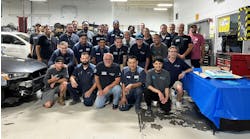The battle between OEMs and the aftermarket continues. As OEMs make public comments discouraging the use of alternative parts, the aftermarket parts industry is combating those statements with research and testing of its own.
FenderBender’s Andrew Johnson sat down with Eileen Sottile, co-chair of the government affairs committee for the Automotive Body Parts Association (ABPA) and executive director for the Quality Parts Coalition (QPC), to discuss the latest news from the aftermarket and the role the QPC is playing in fighting the OEMs.
In addition to your duties with the ABPA, you’re also executive director of the QPC. What led to the creation of that organization?
The U.S. Patent and Trademark Office is issuing a great number of patents on simple repair parts, like hoods, fenders and bumpers. Auto manufacturers are securing 14-year design patents on those parts. So the car companies have now implemented a new business strategy of gathering up all of these patents in order to prevent competition from the aftermarket.
Due to the fact that those patents have been awarded, there’s a presumption of validity to those patents. Aftermarket companies were brought before the International Trade Commission (ITC) with a Section 337 action, claiming patent infringement on 14 parts for the Ford F-150. That’s how the QPC got started.
The Quality Parts Coalition is a Washington, D.C.-based broad coalition. More than 80 companies and associations are part of it. The membership of the QPC includes consumers, aftermarket distributors, manufacturers, collision and service shops, insurers and seniors.
So what is the main focus and goal of the QPC?
The sole purpose of the Quality Parts Coalition is to change the U.S. design patent law. The focus is to secure permanent change to the law so that it would not be considered an act of patent infringement to sell a part solely for the purpose of repair. In other words, providing parts to restore a consumer’s vehicle back to its original condition and appearance would not be considered an act of infringement.
What effect do you see those patents having on the collision repair industry?
If this trend persists, it won’t just affect the aftermarket, but repairers and consumers as well. The use of aftermarket parts helps to prevent total losses of vehicles so that collision repair shops have more work in their bays. Without those parts, collision repairers will start to see more cars totaled out.
The aftermarket will be driven to a point where it will be very difficult to compete, and jobs could ultimately be affected. If the aftermarket can’t compete, consumers with limited resources will be unable to afford to fix their cars. Additionally, if the car companies attain their monopoly of parts, it will add more than $3 billion each year to costs, and insurers will be forced to pass on those increased costs to their policyholders in the form of higher premiums. This is an issue of repairability, not just a parts issue.
What measures are being taken to change the patent law?
There was legislation introduced in the last two sessions of Congress that would allow for the sale of repair parts in order to restore vehicles to their prior condition and appearance. The legislation would allow the aftermarket an exemption from claims of patent infringement on those parts. The bill will have to be reintroduced in the current Congress. The priority of the QPC is to seek early reintroduction of the bills from the last Congress.
It seems logical that OEMs would want to secure patents for their own part designs. Why should the aftermarket be exempt from infringement claims on those patents?
The purpose of this legislation is to recognize the fact that the consumers have the right to restore their cars back to pre-accident condition and have access to a competitive part. When you purchase a vehicle, you’re the owner of that car, and you’re entitled to have a competitive part available so that you’re not forced to go to the dealership for all of your repair and part needs.
But still, shouldn’t OEMs be protected from other companies stealing their designs?
The car companies can still secure patents for their replacement parts and enforce them in the primary market. For example, if Chrysler puts a BMW grill on the front of a Chrysler vehicle, then BMW would still be able to sue Chrysler or bring a case before the ITC against the company.
But there would be competition in the secondary market from the independent parts industry if the parts are for a repair.
How much support does this proposed legislation have?
There is a great deal of support for this bill. We’ve had a number of hearings on Capitol Hill in Washington, D.C. There was a hearing this past spring before the Judiciary Committee on this issue. Members of Congress recognize that consumers are entitled to competition and that lawmakers need to consider having an exemption to allow for parts to be provided in order to repair American motorists’ vehicles.
A main argument against the use of aftermarket parts is that they are not “like kind and quality” compared to OEM parts. How can the aftermarket produce parts of “like kind and quality” if the OEMs have been securing 14-year patents on those parts?
The ABPA and the QPC watch this issue closely. We have found that in the past five years, the cumulative number of car company patents for crash parts has increased from around 450 to more than 1,700.
The car companies criticize the quality of aftermarket parts, but aftermarket products are more easily traceable than OEM parts, and aftermarket companies typically provide customers with lifetime warranties that far exceed those offered by the car companies. Also, nonprofit, non-governmental organizations including NSF International and the Certified Automotive Parts Association (CAPA) do sophisticated, independent testing of aftermarket auto parts to certify their quality. Why are OEMs increasingly matching our prices if we aren’t matching their quality? What consumers may not realize is that some of the same manufacturers of alternative parts also make parts for the OEMs.
This is a hugely contentious issue in our industry, but what about the general public? From your research, where do consumers stand on the issue of aftermarket versus OEM parts?
Market share for the alternative parts industry has been growing. That’s a direct result of the fact that Americans are choosing aftermarket parts because they know they are safe, high quality and more affordable than those offered by the OEMs.
In fact, aftermarket parts typically cost 25 to 50 percent less than the car company parts. Consumers are looking for that option. There’s a growing acceptance of aftermarket and recycled products, and that’s in part why the car companies have chosen to attack the alternative parts industry.
In the present economic climate we have seen a number of studies coming out showing that consumers are keeping their vehicles longer, which of course means relying on repairers who in turn rely on the aftermarket for necessary repairs and maintenance.
Consumers want the car companies devoting time and resources to making sure their cars are safer than they have been in the past, and reducing the number of recalls. That focus would actually serve the American public better than trying to bully the aftermarket. Our hope is that this is the direction the car companies will decide to go in.
Auto manufacturers have made public comments recommending the sole use of OEM parts. They claim that, since they are the original manufacturer of the vehicle, their replacement parts are safer than aftermarket parts. Don’t they have a good point?
First of all, about 95 percent of parts that are sold by the crash parts industry have absolutely nothing to do with safety. The sale of bumper reinforcements is probably less than 1 to 2 percent of any aftermarket company’s sales.
There’s a matter of competitive interests here. The car companies simply want to grow a monopoly in the repair parts market. The OEMs have been fiercely fighting any competition, whether it comes from the aftermarket, re-manufactured parts or recycled parts.
It’s actually pretty ironic that OEMs, especially Ford, are trying to lead consumers into thinking that safety is at issue. Ford, at the last Collision Industry Conference meeting, criticized the use of recycled parts. We all know that Ford sold recycled parts through its Greenleaf program for three years. Does that mean that they should initiate a recall for the recycled parts that they sold?
There are more than 8 million crashes every year. There has never been one single injury or fatality attributed to the use of an aftermarket part. On the other hand, how many millions of vehicles have been recalled by the OEMs for safety problems where people were either injured or killed in their cars?
We’ve all seen that video presentation from the November 2009 CIC meeting showing I-CAR instructor Toby Chess sawing through an aftermarket reinforcement bar, while the same saw could not cut through the comparable OEM part. Did this video lead to any testing on behalf of the aftermarket?
Members of the ABPA did duplicate the same test and achieved a different result. We witnessed the reciprocating saw cut through the OEM reinforcement bar in the same manner and amount of time that it went through the aftermarket reinforcement bar. We achieved a completely different result. And we made our own video to show as well.
The bottom line is this: The saw demonstrations make for good theater, but they don’t tell you anything about how the parts perform in a crash, and how that might impact occupant safety. The only exception might be if you drive slowly into a guy holding a reciprocating saw.
Parts testing by OEMs and aftermarket parts companies, as well as outside organizations, seems to be major part of this debate. What other testing has been done recently that reveals results in favor of the aftermarket?
The National Highway Traffic Safety Administration has the authority to regulate aftermarket crash parts. They have chosen not to because they have determined that aftermarket crash parts are not relevant to occupant safety.
A laboratory crash test performed in December 2010 by MGA Research Corp. revealed that an aftermarket bumper reinforcement bar outperformed its original equipment supplied (OES) part in a 5-mile-per-hour sled test.
When aftermarket and OEM parts performed equally well in trials at 35 mph, the car companies complained that the tests were conducted at too high a rate of speed even though the government requires tests at 35 mph in order to test for occupant safety.
Now that this low-speed test has vindicated the aftermarket in terms of quality, safety and damageability, the focus should return to preventing more cars from becoming total losses which means everyone wins—the repairer, the insurer and most importantly the vehicle owner.
Parts standardization is a huge topic in the industry right now. Is standardization something the aftermarket industry is in favor of?
The goal is to make replacement parts that are equivalent to the OEM replacement parts. The aftermarket industry is doing a good job of that. There do not need to be any additional standards created.
Standardization could create potential problems in terms of supply and distribution for aftermarket companies. That’s because any time you introduce new restrictions, regulations or standardizations, it can have unforeseen and unintended consequences. A domino effect can take place, which not only creates hurdles for supply and distribution, but also ultimately ends up making it harder to deliver the goods the consumers want in a timely and effective manner.
There are a number of different methods that can be used to achieve part equivalency to the OEM replacement part. There are already third-party quality assurance programs in place, like CAPA and NSF. The ABPA is very involved in the NSF Quality Certification Program, which encourages consistency, traceability, and quality of parts. The ABPA has put in a lot of effort in helping to develop this program for distributors. We’re very excited about where this program will take the industry.
Do you see any kind of resolution to the aftermarket parts debate? What will it take for that to happen?
The fact that there have been quality, safe and affordable aftermarket parts in the marketplace for many years without incident speaks volumes. And the more that we’re able to tell our story and educate our peers and legislators about the benefits of aftermarket parts, hopefully we can get to a point where the truth is on the table and we can move forward from there.




